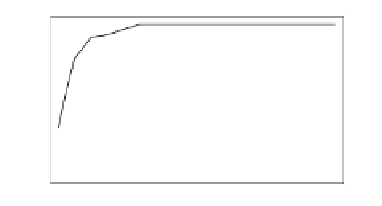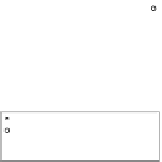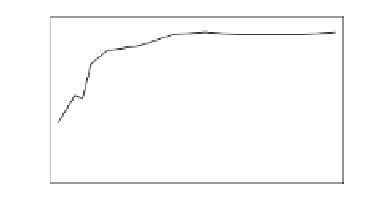Biomedical Engineering Reference
In-Depth Information
80
1
Dry, low frequencies
Dry, high frequencies
Water, low frequencies
Water, high frequencies
Gel, low frequencies
Gel, high frequencies
0.8
60
0.6
40
Dry, low frequencies
Dry, high frequencies
Water, low frequencies
Water, high frequencies
Gel, low frequencies
Gel, high frequencies
0.4
20
0.2
0
0
1.0
1.5
2.0
2.5
3.0
3.5
4.0
4.5
5.0
1.0
1.5
2.0
2.5
3.0
3.5
4.0
4.5
5.0
Stimuli duration [s]
Stimuli duration [s]
Fig. 5.
The impact of stimuli duration ranging from
0
.
75
sto
5
s on: a) average classification
accuracy; b) ITRs
1
1
0.9
0.9
0.8
0.8
0.7
0.7
Gel as ground, low frequencies
Dry as ground, low frequencies
Gel as ground, high frequencies
Dry as ground, high frequencies
Gel as ground, low frequencies
Water as ground, low frequencies
Gel as ground, high frequencies
Water as ground, high frequencies
0.6
0.6
0.5
0.5
1.0
1.5
2.0
2.5
3.0
3.5
4.0
4.5
5.0
1.0
1.5
2.0
2.5
3.0
3.5
4.0
4.5
5.0
Stimuli duration [s]
Stimuli duration [s]
Fig. 6.
Comparison of classification accuracy levels with: a) dry contact electrodes when using gel
and dry electrode as ground; b) water-based electrodes when using gel and water-based electrode
as ground
5.2
Using Dry and Water-Based Electrode as a Ground
To test whether we can design a complete EEG acquisition system using dry or water-
based electrodes we performed additional experiments with Participant 1 where we
replaced the conductive gel ground electrode with the dry or water-based one, respec-
tively. The comparison of classification accuracy using different stimuli duration for
dry electrode setup is shown in Figure 6a. The figure illustrates that the accuracy when
using gel and dry electrodes as a ground is almost the same for both, low and high
frequencies. Moreover, for this participant (short thin hair), the accuracy is higher than
90%
leading to the maximum theoretical bitrate of
86
bpm (
1
s stimuli duration) for low
and
65
bpm for high frequencies (
1
.
25
s stimuli duration). Similarly, Figure 6b illustrates
the comparison of water-based setups when using gel and water-based electrode as a
ground. In this case, the usage of water-based ground electrode results in improved ac-
curacy, leading to bitrates of
88
bpm (
1
.
25
s stimuli duration) for low and
61
bpm (
1
.
125
s
stimuli duration) for high frequencies.
In conclusion, although we cannot infer statistical significance of the presented re-
sults, we can hypothesize that using acquisition setup that is completely based on dry or
water electrodes would not significantly decrease the achieved classification accuracy
over the setup that uses conductive gel as a ground.










































































































































































































































































































































































Search WWH ::

Custom Search